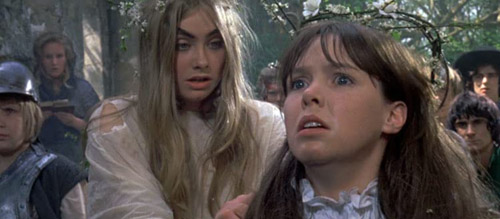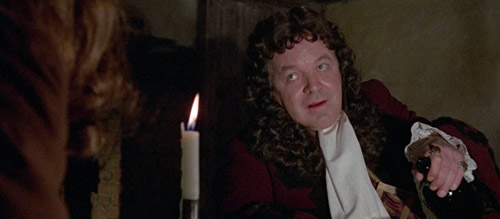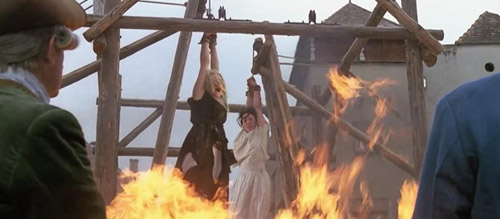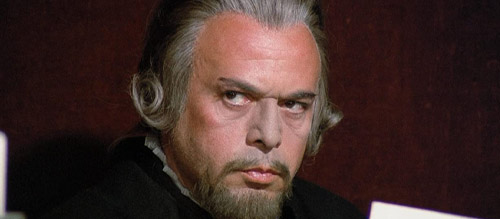Kissing the Devil’s Arse: Witch-Hunting in Eurocult Cinema, c.1968-1976
Blood on Satan’s Claw (1970)
Capitalising on Witchfinder General, Tigon soon moved on to production of Piers Haggard’s Blood on Satan’s Claw (1970). Featuring a similar emphasis on location shooting to Reeves’ film, Blood on Satan’s Claw’s story is initiated by young ploughman Ralph’s (Barry Andrews) discovery of a hideous skull in a field. Ralph’s unearthing of this… thing causes an infection of evil to grow amongst the young people in the rural community in which he lives. This is instigated by the unholy actions of ringleader Angel Blake (Linda Hayden), the first of Ralph’s contemporaries to fall under the spell of the resurrected fiend.
There’s a sense of cosmic horror to the strange, unearthly desiccated remains Ralph uncovers whilst ploughing the field, which allies Blood on Satan’s Claw with other horror films such as Eugenio Martin’s Horror Express (1972), Freddie Francis’ The Creeping Flesh (1973) and John Carpenter’s The Thing (1982). Where the ghastly creature Ralph unearths has come from is uncertain, but nevertheless Blood on Satan’s Claw differentiates itself from Witchfinder General by affirming the very real and present supernatural danger offered by it. The thing seemingly has the ability to possess innocent people – such as Rosalind (Tamara Ustinov), the fiancée of young squire Peter (Simon Williams) – and contact with it leads to individuals growing a patch of ‘satan’s skin’: an inexplicably hairy portion of flesh.
The only figure capable of combating the evil that is spreading throughout the community is The Judge (Patrick Wymark). Initially skeptical (‘These superstitions die hard’), The Judge nevertheless conducts appropriate research and leaves the community, returning to purge it of the spreading evil during a Black Mass that is held in anticipation of the unearthed fiend reaching the height of its powers. Where the local vicar (Anthony Ainley) is powerless in the face of the demon, which uses Angel in order to accuse the vicar of rape, The Judge has the wherewithal to take action. However, he is introduced as a rational man, a disbeliever in the supernatural. When Squire Middleton (James Hayter) and the doctor (Howard Goorney) suggest that recent unusual events have been caused by witchcraft, The Judge scoffs in response. ‘Doctor, witchcraft is dead and discredited. Are you bent on reviving foreign horrors?’, The Judge asks mockingly. ‘You come from the city’, the doctor reminds The Judge, ‘You cannot know the ways of the country’. The doctor lends The Judge a book about demonology, and after perusing this, The Judge leaves the community, promising Ralph that ‘I shall not forget you. I shall return when the time is ripe. But you must have patience, even while people die. Only thus can the whole evil be destroyed. We must let it grow’.
Patrick Wymark as The Judge in The Blood on Satan’s Claw (1971)
The Judge’s strategy is to let the evil grow, to bide time until it can be destroyed just at the moment that it is to reach its apotheosis. In the meantime, the young people of the village commit murder and rape amongst one another in the nearby derelict church. (‘There is growing among you all an insolent ungodliness’, the vicar tells the young people who assemble in the church school for lessons.) In his depiction of the cult-like behaviour of the young people and their murderous activities, writer Robert Wynne-Simmons was influenced by the then-unfolding story of the Manson Family following the arrests that occurred after the Tate-La Bianca murders in 1969, and the case of child murderer Mary Bell (who had been convicted in 1968).
As the crimes committed by the cult members escalate, Peter rides out to meet with The Judge. ‘Your village has been much in my thoughts’, The Judge reassures young Peter. ‘You wouldn’t recognise it, sir’, Peter tells him, ‘Dreadful things are commonplace and mere children commit the foulest deeds [….] They murder one another. We fear that witchcraft has returned’. ‘It is more than witchcraft’, The Judge notes, ‘I am ready to return. But understand, I shall use undreamed of measures’. Meanwhile, the locals plan a witch-hunt of their own, capturing Margaret (Michelle Dotrice) and, in one of the manners of testing an alleged witch outlined in King James’ “Daemonologie”, ‘swimming’ her in the lake. ‘If she sinks, then you done a murder’, one of the villagers says in panic.
When The Judge returns to the village, he notes that ‘This parish is diseased’ and vows, ‘I mean to run this Devil of yours to earth, if he exists’. Nodding to a pack of hounds, The Judge promises that ‘These dogs know how to tear the Devil’s heels’. ‘But sir’, Ralph protests, ‘many are afflicted. Innocent folk may be ‘urt’. ‘Leave me to judge who is innocent’, The Judge asserts. To Margaret, The Judge declares, ‘I have one mission here: to destroy your practices. No consideration will prevent me’. He shoulders off Margaret’s protestations that ‘My Master will take his form [….] You’ll be too late. My Master will be complete. He’ll be too powerful for you!’ The Judge reminds the villagers of the Puritan creed that he embodies: ‘We go about the most fearful business. Only the most strict discipline will save us in our hour of trial’.
The Judge uses the patch of ‘satan’s skin’ that the doctor removed from Margaret’s thigh in order to scent the dogs, who lead The Judge and his rabble to the ruined church where the Black Mass is underway. Young and old are gathered there, a naked woman (Yvonne Paul, the glamour model and Benny Hill girl) dancing seductively and presenting Ralph with a knife with which to cut off the patch of satan’s skin growing on his lower leg – so that the fiend may take its complete form. Wielding a huge broadsword which he brandishes more like a pikestaff, The Judge interrupts the ceremony and leaps in front of the fiend. Haggard here uses freeze frames and slow-motion to extend the confrontation between The Judge and the fiend, and The Judge spears the creature with the sword and lifts it into the flames behind it. The final shot is of The Judge’s face, framed by the flames; a telephoto lens is used to flatten the distance between the flames and his face, as Wymark’s facial expression subtly moves through a range of emotions as The Judge’s surety trickles away, triumph flows into shock. It is a moment comparable to the rightly celebrated final shot of John Mackenzie’s much later The Long Good Friday (1980), in which Harold Shand (Bob Hoskins) realises – in the final moments of the film, after accidentally getting into a car containing the IRA assassins who have been hunting him throughout the film – that he has made his final mistake.
Patrick Wymark’s character of The Judge is one of the few witch-hunting characters to be depicted somewhat heroically – though not unambiguously. The Judge shoulders some of the responsibility for the possession of Rosalind, as it is The Judge who insists she sleep separately from Peter, in the attic room where she is ‘got at’ by the fiend. When Rosalind screams in the night, The Judge prevents Peter from entering the attic room – where Peter’s aunt takes out her bitterness on Rosalind by slapping the girl several times – by striking the young man across the face. Wymark plays the character with an austere sense of purpose and direction, though The Judge is clearly not without his foibles and is particularly taken to drink. Even as the film builds towards its climax, The Judge’s assertion to Ralph, ‘Let me judge who is innocent’, has a sinister ring to it – the words of an absolute authoritarian. However, the community needs this authoritarian figure, to rescue it from the fiend and its influence. In this film, the spreading evil unleashed by the fiend is associated with the cruelties of youth and the cult-like behaviour of the young people; it’s not difficult to see why Blood on Satan’s Claw has often been interpreted as a film that is about the dangers of youth culture, within the context of the youth countercultures of the late 1960s and early 1970s.
Though Christopher Lee and Peter Cushing were considered for the role of The Judge – Lee was reputedly too expensive and Cushing declined because of his wife’s illness – the casting of Wymark seems deeply fitting. It was Wymark who had played Cromwell in Tigon’s previous production, Witchfinder General, and he had also performed as Baron de Laubardemont in the 1961 production by the RSC of John Whiting’s play “The Devils”, later taking over the role of the witch-hunter-cum-exorcist Father Barre when Max Adrian left the production. On Blood on Satan’s Claw, Wymark worked with Michele Dotrice, the daughter of the actor Roy Dotrice, who had also appeared in the RSC’s 1961 production of “The Devils”, as Father Ambrose. (Incidentally, both Wymark and Michele Dotrice were born and raised in Cleethorpes.) The role of The Judge would ultimately prove to be Wymark’s penultimate film role: the actor passed away in October of 1970, before Blood on Satan’s Claw’s release, at the age of 44.
Mark of the Devil (1970)
British films about Protestant witchfinders were soon offset by European films focusing on witchfinders in Catholic territories. Filmed in Austria, Michael Armstrong’s Hexen bis aufs Blut gequält (released in English as Mark of the Devil) was one of the first of such films to be produced in the wake of the European release of Michael Reeves’ Witchfinder General. Armstrong and his German producer Adrian Hoven quibbled on set over various aspects of the script, with Hoven reputedly filming scenes behind Armstrong’s back whilst cutting some of the footage Armstrong had shot.
Mark of the Devil opens with lyrical pastoral music by Michael Holm, which mimics elements of Paul Ferris’ score for Witchfinder General. This is disrupted when Albino (Reggie Nalder), a parochial witchfinder, orders a group of men on horseback to intercept a wagon carrying a priest and a small entourage of novice nuns – who Albino declares to be witches. The wagon is stopped, and the nuns are dragged to the floor and sexually assaulted. With this scene, Mark of the Devil deftly establishes its almost incessant focus on the relationships between witch-hunting, repression and sexual violence. Subsequent to this opening sequence, the priest and nuns are tormented in the village square. The priest is tarred and feathered, and the fingers of one of his hands are hacked off; the nuns are burnt on a scaffold, lowered into the flames in emulation of the staging of the burning of Elizabeth Clarke in Witchfinder General. Where Witchfinder General took a good proportion of its narrative to reach the graphic burning of a woman accused of being a witch, Mark of the Devil almost opens with such a scene, establishing a baseline for the level of cruelty exhibited within the rest of the film. In the film’s scenes of torture, fingernails are pulled out, flesh is burnt with hot irons, people are made to sit on a spiked ‘iron chair’, tongues are cut off, and racks are used.
An onscreen text scroll, accompanied by off-screen narration, attempts to add credibility to the film’s story, thus justifying the exploitative focus on graphic violence by emphasising its relationship with historical fact: ‘This motion picture shows three cases taken from authentic documents of the time when witch-hunting had reached its peak’, this opening scrawl tells us, ‘and can only give a slight idea of the cruelties of one of the blackest pages in the history of man’. As the film opens, the Austrian region which is the primary setting for the narrative is presided over by witchfinder Albino and his advocate (Johannes Buzalski), who as the aforementioned opening sequence indicates, clearly exploit a fear of witches for their own benefit – both in terms of sadistic sexual pleasure and monetary gain. Albino and the advocate are illiterate and fail to keep any records of the cases of witchcraft that they ‘investigate’ – and which lead to the torture and execution of alleged witches. Their complacency is undermined by the arrival of Lord Cumberland (Herbert Lom), an experienced and respected witchfinder, who intends to oversee investigations into cases of alleged witchcraft within the region. Cumberland expects documentary evidence of the trials, which Albino and the advocate struggle to produce. Where Albino is a cynical opportunist, Cumberland appears to be a true believer in witch-hunting. At least initially, Cumberland demonstrates a sense of benevolence, dismissing some of the cases presented by Albino and the advocate. One of the locals describes the arrival of Cumberland, and his conflict with Albino, as ‘Like one vulture devouring another’.
Herbert Lom as Lord Cumberland in Mark of the Devil (1970)
Cumberland is accompanied by his ‘student’, Count Christian von Meruh (Udo Kier). Christian soon falls in love with barmaid Vanessa (Oliviera Vuco). However, having humiliated the crude Albino, Vanessa is soon accused of being a witch; Albino asserts that ‘She has kissed his [the Devil’s] anus, his genitals’. The hyper-sexualised nature of Albino and his advocate’s accusations emphasises the film’s focus on witchfinding as a form of sexual mania that manifests itself as a desire to rid society of ‘impurities’: witch-hunting is thus depicted almost as a fetish, the act of interrogation or torture serving the sadistic sexual desires of the witchfinder. Albino’s repressed sexuality manifests itself in sexual violence, and jealousy towards the handsome Christian – who Albino refers to as ‘that dolled-up, noble pansy’. However, when Vanessa is accused in front of Cumberland of concocting spells in order to cause men to become impotent, a nerve is struck within Cumberland; and to Christian’s dismay, Cumberland fails to dismiss Vanessa, and he reminds Christian that ‘Just one hour before Lucifer’s fall, God thought he was an angel. She [Vanessa] will confess’.
Again, as in Witchfinder General, Mark of the Devil avoids any depiction of the supernatural, instead drawing focus on its story of human cruelty. ‘The Devil doesn’t exist’, one of the villagers asserts near the start of the film, ‘At least you can see the witch-hunters’. Likewise, Vanessa is a materialist who tells Christian, ‘I would only believe the Devil if I see him… And witches don’t exist either’. The naïve barmaid is ultimately proven to be far more rational than the film’s various figures of patriarchal authority. As the story progresses, Christian becomes embroiled in the story of Baron Daumer (Michael Maien), a nobleman who Cumberland has arrested. If Daumer confesses, his properties and land will fall into the possession of the Church, and Daumer protests that his arrest for sorcery is a ploy by the Bishop to confiscate Daumer’s wealth. Cumberland promises to give Daumer clemency, if Daumer will sign over his estates to the Church.
Cumberland is initially depicted sympathetically, especially in contrast with the spiteful Albino; but as the narrative progresses Cumberland becomes as cruel as his more parochial counterpart. In Cumberland’s early scenes, he brushes aside the ludicrous claims of witchcraft put forward by Albino and his accomplice. However, Cumberland becomes increasingly cruel, especially in response to claims of his sexual impotence – culminating in his murder of Albino. ‘I need confessions, not martyrs’, Cumberland asserts over the cries of the tortured, later adding that ‘We must never weaken in performing God’s work […] For those who turn against our Saviour, no punishment is sufficient’. The arrest of Daumer is a minor turning point in terms of Christian’s relationship with his mentor: Daumer’s claims that his arrest for witchcraft is simply motivated by the Bishop’s desire to confiscate Daumer’s estates causes Christian to question the motives of Cumberland. Cumberland’s murder of Albino, which is witnessed by Christian, is motivated by Albino’s suggestion that despite their superficial differences, he and Cumberland are alike: Cumberland simply presents a more refined version of the brutality that is embodied by Albino. ‘You get a thrill out of seeing them on the rack, don’t you’, Albino goads Cumberland, ‘You’re a man, just like me. You misuse God’s name for your own ends’. Albino’s use of the word ‘impotent’ causes Cumberland’s rage to escalate, with the result that Cumberland throttles Albino to death. Following this act, Cumberland becomes increasingly vociferous in his use of torture – particularly in the case of Baron Daumer.
Reggie Nalder as Albino in Mark of the Devil (1970).
At one point in the narrative, a nobleman (played by the film’s producer, Adrian Hoven) and his wife (Ingeborg Schöner) are arrested during a puppet show they are performing for their children. The puppeteers make the error of saying that his puppets ‘have a magic effect on everyone. They captivate young and old, these cute little devils’. The nobleman and his wife are accused of ‘practising magic using the intermediary of puppets with lifelike human voices’, and he is tortured in front of his children. In front of Cumberland, the nobleman and his wife are accused of making a deal with the Devil in order ‘to trap human souls’ in the puppets. In response, the nobleman’s wife pleads that the plays that the couple staged using the puppets were meant to be ‘educational’: they were intended to be a form of moral instruction. In this sequence, Mark of the Devil engages with the issues surrounding the repression and censorship of potentially challenging artworks such as films. Within the film’s narrative, the potential censor is represented in the morally compromised figure of the witchfinder. This was presumably intentional on the part of the filmmakers, who no doubt anticipated censorship problems in some territories given how graphic much of the film’s violence is. Certainly it is ironic, given that Mark of the Devil was one of the titles seized during the ‘video nasties’ moral panic that swept the UK in the early 1980s.
When Christian pleads with Cumberland to release the puppeteer and his wife, Cumberland responds by telling Christian that ‘They have been publicly accused of witchcraft. To acquit them would show weakness’. Cumberland adds, ‘They must die as martyrs’. To this, Christian responds pointedly by asserting, ‘If they die as Christian martyrs, what do their deaths make you?’ The film builds towards a nihilistic conclusion, Christian confronting Cumberland directly and telling him that ‘You talk a lot about God, but you really mean the Devil’. The villagers revolt and turn on Cumberland, who flees. However, Christian is lynched for his association with Cumberland, Albino’s advocate using an implement which closes around Christian’s waist and pierces his abdomen in numerous places, as Vanessa picks her way through an array of corpses to be reunited with her beloved in his final moments. As the advocate tortures Christian, a crowd of villagers watch in glee and then disperse, the scene offering an echo of the opening sequence from Witchfinder General. We are left wondering how a community may survive such abominable horrors, engendered by the persecution of alleged heretics in the service of financial and political gain – not to mention simple sadism.
Reputedly, the original ending of Mark of the Devil featured the dead bodies of those persecuted by the witchfinders rising from the ground. This was removed from the film and destroyed by producer Hoven, though some stills from this footage exist. Given the rest of the film’s incessant denial of the supernatural and its focus on man’s cruelty to his fellow man, it’s difficult to imagine this ‘missing’ ending working in situ, and its removal was probably for the best.






